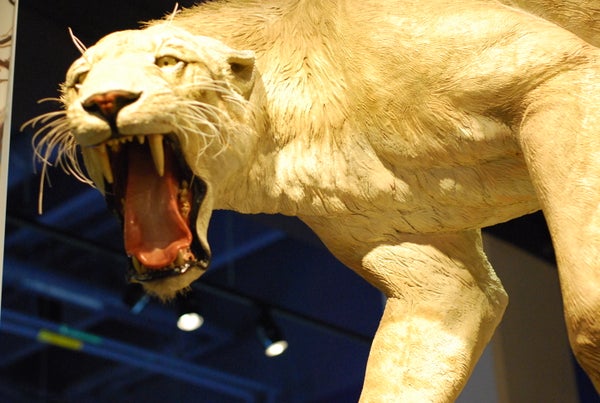This article was published in Scientific American’s former blog network and reflects the views of the author, not necessarily those of Scientific American
When it comes to Ice Age DNA, mammoths get the lion’s share of attention. Maybe it’s because of their charisma. Maybe it’s because the amazing carcasses thawing out of the Siberian tundra make paleogeneticists dance with glee. Whatever the reason, we’ve learned quite a bit about these megamammals from the remaining tatters of their genomes. But they’re not the only Pleistocene animals to have their As, Gs, Ts, and Cs analyzed. There’s been a growing effort to understand Ice Age carnivores, with saber-toothed cats having pride of place.
Part of the reason sabercats have lagged behind is that specimens for suitable ancient DNA analysis are harder to find. (Even though hundreds of Smilodon are known from La Brea, for example, the process required to ready the bones for genetic analysis would destroy the remains of genes scientists seek.) Still, paleogeneticists Johanna Paijmans, Ross Barnett, and colleagues were able to draw from enough Ice Age bones to assemble nearly complete mitochondrial genomes for Smilodon and Homotherium. What they found bolsters some previous hypotheses, but, in other ways, revises what was expected based on bones alone.
It’s easy to see that Smilodon and Homotherium are a breed apart from other cats. Paleontologists have long known that these sabercats belonged to a group distinct from today’s felids, which experts call the machairodonts. The new analysis underscores that point. But sabercats were not just one branch. They were a diverse family of sharp-toothed pouncers, and the new study estimates that Smilodon and Homotherium – often characterized as representative of two major sabercat subsets – last shared a common ancestor about 18 million years ago.
On supporting science journalism
If you're enjoying this article, consider supporting our award-winning journalism by subscribing. By purchasing a subscription you are helping to ensure the future of impactful stories about the discoveries and ideas shaping our world today.
Regarding the scimitar-toothed Homotherium, though, Paijmans and colleagues came up with some curious results. Part of their fossil sample included a purported Homotherium jaw recovered from the North Sea. Radiocarbon dates placed the fossil at about 28,000 years old, but this was about 200,000 years younger than the last confirmed occurrence of the cat in Europe. This seemed a bit of a stretch, to be missing the cat for such a broad slice of time, but the genetic analysis confirmed that the jaw pulled off the Dutch coast really did belong to Homotherium. The cat was rare, the researchers note, and may have been living in fragmented populations, but it hung on for far longer than previously thought.
And there was another twist to the Homotherium story. Based on bones, paleontologists recognized at least two species of the cat – Homotherium serum in North America and Homotherium latidens in Eurasia. These cats were separated by over a thousand miles and over 25,000 years. Yet, when the researchers looked at their three samples of Homotherium through space and time, they found very little genetic diversity. This means, as previous studies had suggested, that there was probably just one Homotherium species across the Northern Hemisphere, connected by their genes. Homotherium latidens, one cat to rule them all.
Reference:
Paijmans, J., Barnett, R., Gilbert, M., Zepeda-Mendoza, M., Reumer, J., de Vos, J., Zazula, G., Nagel, D., Baryshnikov, G., Leonard, J., Rohland, N., Westbury, M., Barlow, A., Hofreiter, M. 2017. Evolutionary history of saber-toothed cats based on ancient mitogenomics. Current Biology. doi: 10.1016/j.cub.2017.09.033
